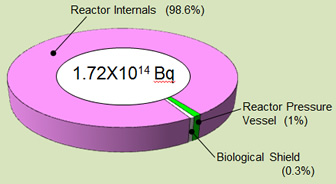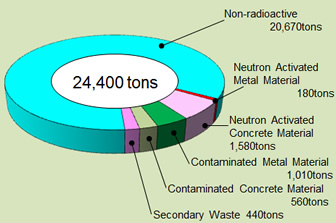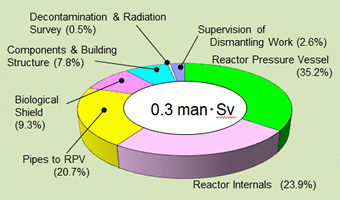JPDR(Japan Power Demonstration Reactor)
Outcome of the JPDR decommissioning program
The following are the major outcome of the JPDR decommissioning program.
- ●Development of remote dismantlement technology for highly activated steel structures, etc.
- ●Development of dismantlement technology for biological shield concrete.
- ●Establishment of decontamination techniques and measurement methods for concrete structures with surface contamination.
- ●Development of computer codes for radioactive inventory evaluation.
- ●Development of remote dismantlement technology to reduce worker exposure.
- ●Training of engineers for decommissioning of nuclear facilities.
Radioactive Inventory
Overall, 98.6% of the residual radioactivity was found in the reactor core internal structures such as the core shroud and the grid plate. About 1.0%, 0.3%, and 0.1% remained in the reactor pressure vessel, the radiation shielding concrete, and the contaminated equipment, respectively.

Waste Amount
The total amount of the solid waste generated from dismantling the JPDR was 24,440 tons, and about 85% of it was non-radioactive waste. About 2,100 tons of radioactive waste was packed into containers, such as drums and shielded containers, which were stored in the radioactive waste storage facilities. About 1,670 tons of very low level concrete waste was disposed of in the Disposal Test Facility to demonstrate the safety of simple earthen trench disposal.

Worker Dose
The collective dose equivalents owing to external exposure in the course of dismantlement of the JPDR facility were about 0.3 man-Sv. This is 1/3 of the value originally estimated. The collective dose equivalents in the decommissioning of the JPDR is less than those incurred during decommissioning of the Shippingport Atomic Power Station in the United States, which were about 1.5 man-Sv.








